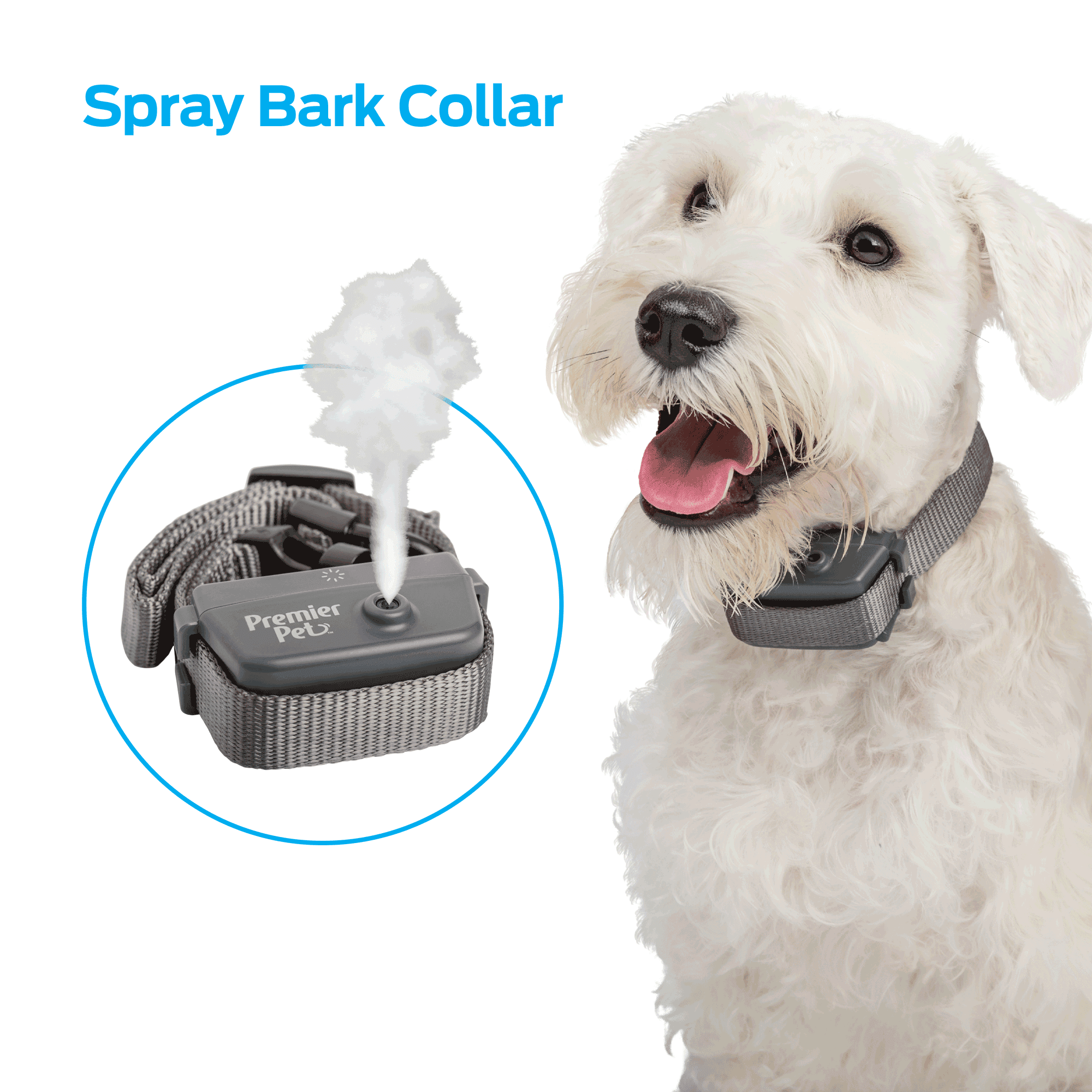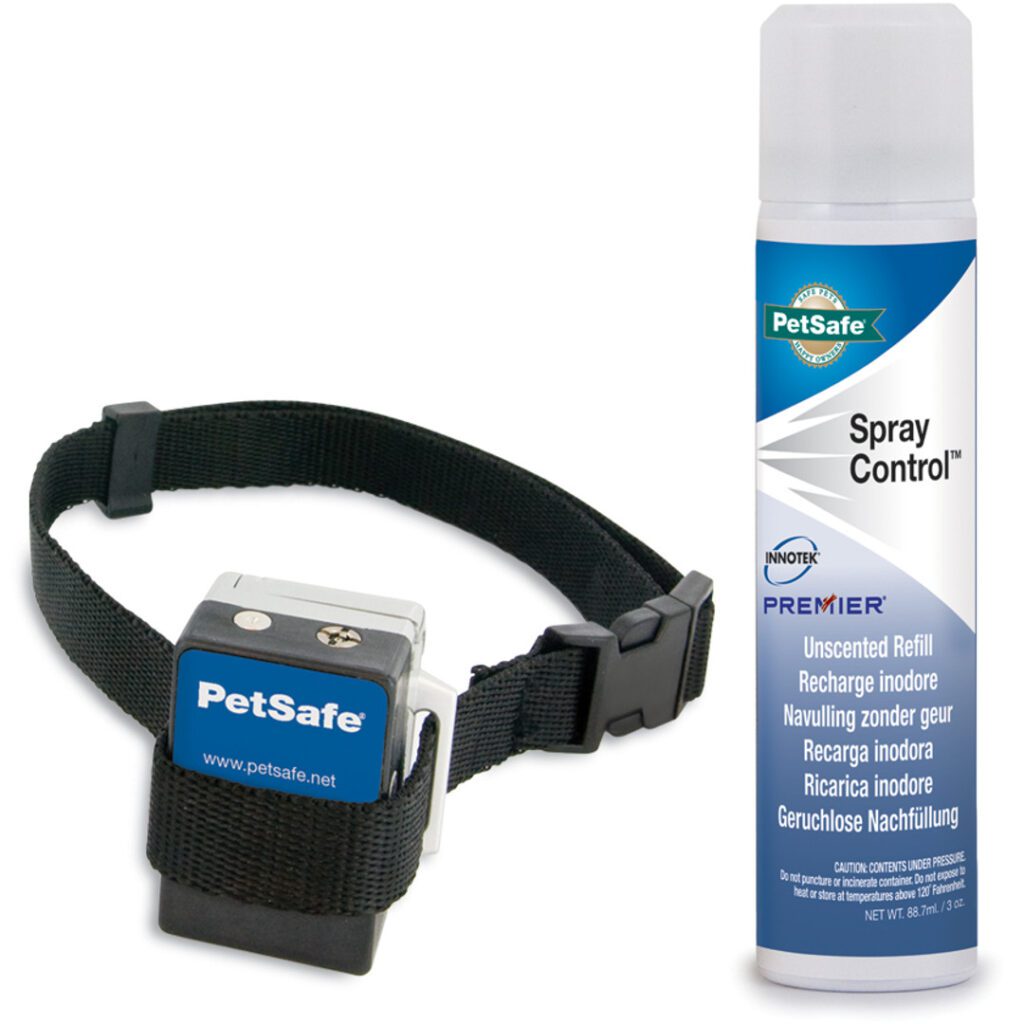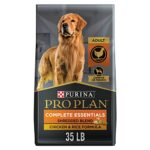A dog bark spray collar releases a mist to deter unwanted barking. It’s a humane alternative to shock collars.
Dog bark spray collars are gaining popularity among pet owners seeking non-shock methods to curb excessive barking. These devices release a harmless spray, often of citronella or water, which surprises the dog and interrupts its barking pattern. As a training tool, they can be effective when used consistently and paired with positive reinforcement techniques.
They are designed to be lightweight, comfortable, and adjustable to fit various dog sizes. This behavior modification device provides an immediate response to barking, enabling dogs to associate their noise with the consequence of an unpleasant scent or sensation, thereby encouraging them to stay quiet. It’s essential for dog owners to choose the right collar and use it responsibly to ensure their pet’s well-being while addressing nuisance barking.
Introduction To Dog Bark Spray Collars
Dog bark spray collars are a popular tool for pet owners.
They help manage barking in dogs. These collars use a gentle method.
They release a spray. The spray is harmless. It surprises the dog. The surprise stops the barking.
What are they?
Dog bark spray collars are a type of training device. They fit around your dog’s neck.
When your dog barks, the collar triggers. It releases a burst of spray. The spray is usually citronella.
Citronella is safe for dogs.
- Customizable: You can set the sensitivity.
- Battery-powered: Collars use batteries.
- Automatic: They work without human intervention.
How They Fit Into Training
Consistent training is key for dog behavior. Bark spray collars can be part of this.
They are tools. They are not replacements for training.
| Training Aspect | Collar’s Role |
|---|---|
| Bark Management | Automatically corrects barking. |
| Behavior Modification | Complements commands and rewards. |
Remember to always stay positive with your dog.
Use treats and praise. Combine these with the collar. This way, your dog will understand.
Good behavior brings good things.
Types Of Bark Control Collars
Dog owners seek solutions to manage excessive barking. Bark control collars offer such solutions. These collars come in different types. They signal the dog to stop barking. This section explores the various bark control collars available.
Spray Collars Vs. Shock Collars
Spray and shock collars are popular choices. Spray collars emit a harmless but annoying mist. Shock collars deliver a static correction. Owners often prefer spray collars for a gentler approach. Shock collars might suit stubborn barkers. It’s vital for the owner to choose with care.
- Spray Collars
- Use citronella or unscented sprays.
- Activate by barking vibrations or sound.
- Considered safe and humane.
- Shock Collars
- Administer a mild electric shock.
- Adjustable intensity levels.
- Some controversy regarding their use.
Automatic Vs. Manual
Collars can be automatic or manual. Automatic collars react to barking without human intervention. Manual collars require an owner’s input. Both types aim to train dogs effectively. The choice depends on owner preferences and dog behavior.
| Automatic Collars | Manual Collars |
|---|---|
| Activate by themselves. | Controlled by a remote. |
| Suitable for consistent training. | Allow for situational correction. |
How Spray Collars Work
Dog bark spray collars are a popular tool to help manage excessive barking.
These collars use a gentle method to create a distraction that stops barking.
The Mechanism Behind The Spray
At the core of the dog bark spray collar is a clever device that detects barking.
Once it senses your dog’s bark, it triggers a burst of spray.
The spray is harmless and is just strong enough to surprise your pet and interrupt the barking pattern.
Safety And Effectiveness
Dog bark spray collars are designed with your pet’s safety in mind.
They use a citronella or unscented spray which is safe for dogs and humans.
- Shock-free, relying on a gentle approach
- Adjustable sensitivity to suit your dog
- Scientific studies support their effectiveness

Credit: www.amazon.com
Choosing The Right Bark Spray Collar
Choosing the right bark spray collar for your dog involves several key factors. From the size of your furry friend to the specific settings of the device, each aspect plays a critical role.
Size And Breed Considerations
All dogs are unique. Size and breed matter greatly when selecting a bark spray collar. A Chihuahua, for instance, needs a much lighter and smaller collar than a Labrador. Finding the perfect fit ensures comfort and efficiency.
- Small Breeds: Opt for adjustable collars designed for neck sizes from 6 to 20 inches.
- Medium Breeds: Choose collars that cater to 10 to 22-inch neck sizes.
- Large Breeds: Look for collars that fit 16 to 28 inches neck sizes.
Always measure your dog’s neck before making a purchase. Check for collars with flexible straps to get the right fit.
Intensity And Sensitivity Settings
Effective training requires the right levels of correction. Dog bark spray collars come with variable settings that should match your dog’s temperament. A sensitive dog may need a lower intensity, while a more stubborn breed could require a higher setting.
| Sensitivity Level | Dog Temperament |
|---|---|
| Low | Shy or Timid |
| Medium | Moderate |
| High | Stubborn or Elderly |
Test different settings to find the gentlest yet effective level for your dog. The collar should have a range of adjustability to ensure training effectiveness without causing distress.
Training With A Bark Collar
Insert additional meta tags and keywords relevant to dog training and bark collars here
Teaching your dog to be quiet can be a challenge. A bark spray collar helps. It uses a gentle spray to stop barking. Let’s learn to use it right.
Integrating Collar Use Into Training
Start with the basics. Get your dog used to the collar before turning it on. Wear the collar for short periods during the day. This helps your dog feel comfortable.
Set specific training sessions. This keeps your dog focused. Use these steps:
- Put on the collar right before a training session.
- Keep sessions short, about 10 to 15 minutes.
- End with a fun game or treats to keep it positive.
Positive Reinforcement Techniques
Positive reinforcement works wonders. Pair the collar with treats and praise. Here are key points:
- Right after the collar sprays, direct your dog to a quiet activity.
- Give a treat when your dog responds well.
- Use a happy voice to encourage quiet behavior.
Pros And Cons Of Bark Spray Collars
Is your furry friend’s incessant barking driving you and your neighbors mad? A bark spray collar might be what you need. This device can help control your dog’s barking in a humane way. But like all solutions, it has two sides. Let’s weigh these options together.
Advantages Of Non-shock Method
- Humane Training: No electric shocks ensure your pooch stays happy.
- Effective Deterrent: A surprising spray gets your dog’s attention.
- Adjustable Intensity: Customize the collar to fit your dog’s sensitivity.
- Less Anxiety: No pain means a less stressed pet.
Potential Drawbacks To Consider
| Potential Drawback | Description |
|---|---|
| Refills Needed: | Regular purchase of spray refills is necessary. |
| Wind Sensitivity: | Effectiveness can reduce in windy conditions. |
| False Triggers: | Other noises can accidentally activate the collar. |
| Maintenance: | Regular cleaning and upkeep are required. |
User Experiences
User Experiences with Dog Bark Spray Collars can differ widely. Many pet owners turn to these devices in hopes of finding a solution to excessive barking. Real-world feedback provides valuable insight into their effectiveness and usability. In this section, we explore diverse narratives from dog owners who have tried these collars.
Success Stories
Pet owners have shared inspiring tales of how bark spray collars helped their dogs. Positive outcomes are common among satisfied users:
- Lasting quiet: Families enjoy peace as constant barking turns into calm behavior.
- Stress relief: Owners report reduced anxiety for both themselves and their pets.
- Improved training: The collar complements other training methods for better results.
Challenges Faced
Not all experiences are smooth. Some users face hurdles when using dog bark spray collars:
- Sensitivity adjustments can be tricky, leading to the collar activating at the wrong time.
- Refilling the spray becomes a regular task that requires attention and refills.
- Dogs may become anxious or fearful if not introduced to the collar carefully.
| Challenge | Solution |
|---|---|
| Incorrect Activation | Consult manual; adjust collar sensitivity. |
| Frequent Refills | Set reminders; buy in bulk. |
| Negative Behavior | Introduce collar gradually with positive reinforcement. |
Maintenance And Care
Keeping your Dog Bark Spray Collar in top condition ensures it works well and lasts longer. Proper maintenance and care can also keep your pet safe and comfortable. Follow these simple steps to look after your collar effectively.
Cleaning The Collar
Regular cleaning is crucial for your Dog Bark Spray Collar. Dirt, sweat, and oils can build up on the collar over time. This buildup can affect the collar’s function and cause discomfort to your dog. Here’s how to clean it:
- Remove the collar from your dog.
- Detach the spray device if possible.
- Use a damp cloth with mild soap to gently wipe the collar.
- Ensure the collar is completely dry before refitting.
Refilling The Spray
The spray in the collar should be refilled regularly. Using the correct solution is important as it ensures the collar works correctly and is safe for your dog.
- Turn off the collar and remove the spray canister.
- Hold the refill can upright.
- Insert the nozzle into the refill port.
- Press firmly to refill the spray canister.
- Replace the canister and turn the collar back on.
Always check the manufacturer’s instructions for the proper refill method and recommended spray solutions. Keep spare spray cans handy to ensure uninterrupted training and correction.
Common Concerns Addressed
Many pet owners today are exploring ways to manage their dogs’ barking habits. Among the popular tools is the dog bark spray collar. While useful, some concerns often surface regarding their operation and impact on our canine friends. This portion of the blog aims to shed light on these worries and provide clear information for pet owners.
Is It Cruel?
The concept of using a spray to discourage barking can prompt worries about cruelty. Dog bark spray collars are designed to be humane and safe. They work by emitting a harmless spray, which distracts the dog from barking and conditions them to avoid the behavior. Pet experts advocate for their gentleness compared to shock collars. The collars use natural scents like citronella, which are not harmful to dogs. It is essential to follow manufacturer guidelines for the best results and ensure the pet’s comfort.
Can It Cause Confusion In Dogs?
Owners might worry that dogs could become confused by the spray’s interruption. Consistent training is key to avoid confusion. When a bark collar is used appropriately, dogs can understand and learn from the pattern: bark leads to spray; no bark means no spray. It is crucial to complement the use of a bark spray collar with positive reinforcement. This way, dogs not only learn to avoid unwanted barking but also get clear signals about the behavior their owners desire. Consistency in training ensures dogs associate the spray with their barking and nothing else.

Credit: www.amazon.com
Legal And Ethical Considerations
When choosing a dog bark spray collar, it’s crucial to consider the rules and well-being of your pet. Laws and morals guide proper use. Let’s dive into these important aspects.
Regulations On Use
Each country and state has different rules for bark control devices. Here are key points:
- Check local laws before purchasing.
- Some areas may require a permit.
- Use may be restricted in certain public spaces.
| Region | Regulation |
|---|---|
| USA | Varies by state |
| EU | Requires CE marking |
| Australia | Licensed use in some territories |
Animal Welfare Implications
Always consider your dog’s health and happiness. Here’s how:
- Choose collars with humane certification.
- Train with positive reinforcement first.
- Consult a vet if behavioral issues persist.
Responsible pet ownership combines legal compliance and ethical treatment. By following regulations and focusing on animal welfare, owners ensure their furry friends stay safe and content.
Alternatives To Bark Spray Collars
Many pet owners seek gentle methods for training their furry friends. Not everyone is comfortable with bark spray collars. Let’s talk about kinder alternatives that are just as effective. These options cater to different dog personalities and training needs.
Behavioral Training
Dogs learn from consistent patterns and rewards. Behavioral training focuses on understanding why dogs bark and addressing the root cause. Positive reinforcement is at the core of this approach. Encouraging good behavior with treats, praise, or play can be much more effective than punitive measures. Professional dog trainers can offer personalized advice, but here are some tips to start with:
- Ignore the barking: Wait until your dog stops barking to give attention.
- Teach the ‘quiet’ command: Start during calm moments and gradually introduce the command when your dog barks.
- Stay calm: Dogs can sense anxiety which might increase their barking.
- Provide mental stimulation: Boredom can lead to excessive barking, so try puzzle toys or brain games.
Other Anti-bark Devices
When behavioral training needs a little support, consider these non-spray devices. They aim to redirect your dog’s attention without causing distress.
| Device Type | How It Works | Consideration |
|---|---|---|
| Ultrasonic Devices | Emits a high-pitched sound only dogs can hear. | Some dogs might ignore it, or it can affect other dogs in the area. |
| Vibration Collars | Delivers a harmless vibration to distract the dog. | More sensitive dogs might find this distressing. |
| Static Shock Collars | Produces a mild electric shock when barking is detected. | Controversial due to the potential for distress and fear. |
These devices can be adjustable in intensity and often come with remote controls for supervised training sessions. Always read reviews and consult with a vet before trying a new device.

Credit: www.walmart.com
Frequently Asked Questions For Dog Bark Spray Collar
Do Dog Bark Spray Collars Work?
Dog bark spray collars can reduce barking by emitting a spray that distracts and deters the dog from continuing to bark. Their effectiveness varies with each individual dog’s temperament and training.
Do Vets Recommend Bark Collars?
Most vets do not recommend bark collars due to the potential for negative behavioral effects. They advocate positive training methods instead.
How Does Petsafe Spray Bark Collar Work?
The PetSafe spray bark collar detects your dog’s bark and releases a harmless spray to discourage excessive barking. It uses a microphone and a vibration sensor for accuracy.
Are Bark Collars Ok For Dogs?
Bark collars can be controversial and are not recommended by many veterinarians and animal behaviorists. Proper training is a safer and more effective solution for excessive barking.
Conclusion
Deciding on solutions for excessive barking can be challenging. The dog bark spray collar presents a humane alternative, offering corrective feedback without harm. Through consistent use, it encourages better behavior in our canine companions. Remember to choose compassionately and consult with a vet for the best approach for your furry friend.







